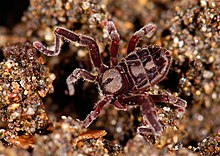
Ricinulei is a small order of arachnids. Like most arachnids, they are predatory, eating small arthropods. They occur today in west-central Africa (Ricinoides) and the Neotropics as far north as Texas. As of 2021, 91 extant species of ricinuleids have been described worldwide, all in the single family Ricinoididae. In older works they are sometimes referred to as Podogona. Due to their obscurity they do not have a proper common name, though in academic literature they are occasionally referred to as hooded tickspiders.
Sandokanidae is a family of harvestmen in the suborder Laniatores, formerly referred to as Oncopodidae
Geaya is a genus of harvestmen in the family Sclerosomatidae from Latin America.

Cryptocellus is an arachnid genus in the order Ricinulei, first described by John Westwood in 1874.
Cryptocellus adisi is an arachnid species in the order Ricinulei. It occurs in Central Amazonia in Brazil.

Cryptocellus becki is an arachnid species in the genus Cryptocellus. It can be found in the Amazon rainforest.
Metagonia is a genus of cellar spiders that was first described by Eugène Louis Simon in 1893.

Phrurolithus is a genus of araneomorph spiders first described by C. L. Koch in 1839. First placed with the Liocranidae, it was moved to the Corinnidae in 2002, then to the Phrurolithidae in 2014.



